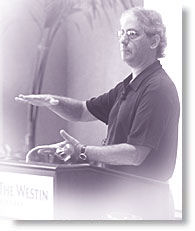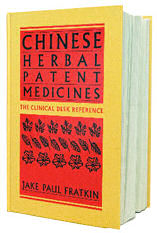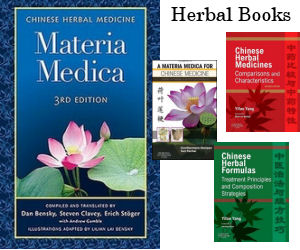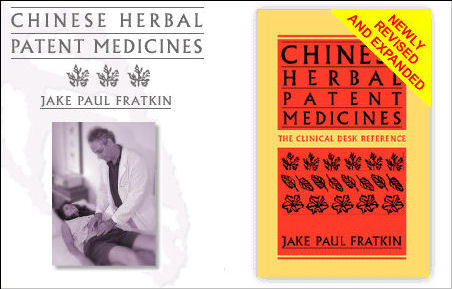Acupuncture & TCM Articles

Articles by Jake Paul Fratkin, OMD, LAc
Jake Fratkin, OMD, LAc, has been in the practice of Oriental medicine since 1978. Following undergraduate and graduate training at the University of Wisconsin in Chinese language and philosophy and pre-medicine, he pursued a seven-year apprenticeship in Japanese and Korean style acupuncture with Dr. Ineon Moon and a two-year apprenticeship in Chinese herbal medicine with Drs. Zhengan Guo and Pak-Leung Lau in Chicago. He also spent a year in Beijing hospitals interning in advanced herbal medicine, specializing in gastrointestinal and respiratory disorders, and pediatrics.  Dr. Fratkin is the author of several books, including Chinese Herbal Patent Medicines: The Clinical Desk Reference, and is the editor-organizer of Wu and Fischer's Practical Therapeutics of Traditional Chinese Medicine. In 1999, he was named the "Acupuncturist of the Year" by the American Association of Oriental Medicine.
Dr. Fratkin is the author of several books, including Chinese Herbal Patent Medicines: The Clinical Desk Reference, and is the editor-organizer of Wu and Fischer's Practical Therapeutics of Traditional Chinese Medicine. In 1999, he was named the "Acupuncturist of the Year" by the American Association of Oriental Medicine.
Chinese Herbal Patent Medicines: The Clinical Desk Reference
Hardback book, 1198 pages. This volume covers 1360 products, including 550 GMP level products and all of California FDB analysis on 505 products. Includes information on endagered animals, heavy metals, and pharmaceuticals. The text is organized into 12 groups, with a total of 109 chapters and includes material by Andrew Ellis, Subhuti Dharmananda, and Richard Ko. Over 80 pages of full-color photos (with English and Chinese cross-reference). Fully indexed.
HEPATITIS C:
Differentiation and Treatment According to Wu Boping
Dr Wu Boping has been one of the most renowned physicians and teachers at the China Academy of Traditional Chinese Medicine in Beijing. Recently retired, he has divided his time between Beijing and Florida, and has now returned to China. A student of Qin Bowei, Wu Boping is considered an authority on internal medicine, especially liver disease. His experience in treating hepatitis C is extensive both in China and the United States, and his observations and treatments offer a unique contribution. The following is taken from a lecture he gave in the United States in May, 1999. I have taken the liberty of presenting Dr. Wu´s lecture in his own voice. Any mistakes or errors of fact are mine. – Jake Frat kin, OMD.
I want to talk about the treatment of hepatitis C. It is recognized as a major health problem in the United States, and of course it is becoming a problem in China. I am retired now, but in my last three years of clinical practice in Beijing, I ran a clinic that specialized in liver disorders. We saw many cases of hepatitis, A, B, and what we then called non-A, non-B. When I came to Florida to teach (at the Atlantic Institute of Oriental Medicine, Ft. Lauderdale), I saw many American patients with hepatitis C. So I feel that I have some experience in this area.

The Academy of Traditional Chinese Medicine was started in 1956, in Beijing. At the present time, it consists of four large hospitals and 11 research institutes. I was a graduate of the first class, and have been associated with the Academy for over 40 years.
In discussing hepatitis, it is best to base treatment on the classical approach. This is true for all diseases. We can treat modern diseases such as endometriosis, AIDS, and so on, but we still use the traditional method of differentiation, of treating the stage of the disease. Another way of saying this is that we treat the patient´s presentation, not the name of the disease.
Using the classical formulas is still the best approach, because the formulas that
have survived are the best formulas. And differentiation does not just apply to a patient's presentation. It can have broader implications. Let me give you an example. In a serious
viral encephalitis epidemic in Beijing in 1955, Dr. Gua used Bai He Tang. This simple
formula worked to great effect. The next year, however, the formula did not work. Why? It is because 1955 was a metal year, and 1956 was an earth year. Dr. Gua said, add Cang Zhu to dispel damp. And this worked.
Let's look at Bai He Tang. Shi Gao is the main herb to reduce heat, but it can be too drying. We add Zhi Mu to add moisture, to tonify yin. Gu Ya nourishes qi consumed by heat, and Gan Cao harmonizes the formula. This formula was created based on clinical experience, on clinical application to millions of people over hundreds of years. It´s important to study the classical formulas, to know them well. It is also important to study the medical classics - the Nei Jing, Nan Jing, Shang Han Lung, and the Wen Bing.
There is no one formula for a disease. A disease progresses through various stages, and a good doctor must find the stage that the individual is presenting. This idea was first shown in the Shang Han Lun, almost 2000 years ago. People change, diseases change, and you need to change and adjust the formula accordingly.
The treatment of hepatitis must be done according to its stage. This applies to all types of hepatitis: A, B and C. Previously hepatitis A was the most observed, and we had a lot of experience. Now, we have B and C. Type C is very different; the virus directly attacks the DNA inside liver cells, and can lead to cirrhosis or cancer. This is very serious, and is often fatal. Trying to kill the virus as the main strategy is not effective; it will not work. You cannot kill the virus when it is inside the cell, before it ruptures. What we can do is treat the damaged liver, so as to slow down the rate of the disease and prevent cirrhosis or cancer. This cannot be done with antiviral herbs; it is necessary to treat the whole body. Traditional Chinese Medicine gives good results, especially when combining acupuncture and herbal medicine.
We can divide all hepatitis into three stages, primary, middle and late. In the following discussion, we will talk about each stage, with its sub-differentiations, first with signs and symptoms, and afterwards, treatment for each stage.
PRIMARY STAGE SIGNS AND SYMPTOMS. This is mostly applicable to acute hepatitis A. In the earliest part of the disease, it affects the liver and spleen, and is usually marked by fatigue. Jaundice is only occasional, perhaps 10% of the patients. When jaundice appears, this is a damp-heat stage affecting the blood. We can also say that it is mainly heat with some dampness affecting either the stomach and spleen, the liver and gallbladder, or all. If you can cure the disease at this stage, there will be no further manifestations.
If not, the symptoms that appear are fever with chills, nausea and abdominal gas. Although we do not see this stage in hepatitis C, I do want to mention it.
In hepatitis C, this first stage doesn´t really show. That is because C is a disease of the blood, not the liver and spleen. There is no primary stage. Symptoms happen once the liver cells are damaged. The main symptom is fatigue, but it is extreme. Often, a doctor might suspect chronic fatigue or even multiple sclerosis. The blood must be checked for the hepatitis B or C antibody. Check their history to see if there was a blood transfusion, drug use, sex with an infected partner, and so on. It is rare, but it can also be spread through broken mouth ulcers, from a dentist using contaminated instruments, or multiple use of the same toothbrush when there is gum disease.
MIDDLE STAGE SIGNS AND SYMPTOMS. This stage is one of qi and blood stagnation. There are two root causes, and, as subcategories, should be treated differently.
1) Deficiency of Spleen Qi and Yang. This stage is predominantly damp accumulation, which blocks the flow of qi and leads to blood stagnation. The main symptoms are fatigue, dizziness, no appetite, nausea, occasional vomiting, and abdominal bloating. It is often accompanied by gas, which is due to a cold dampness. Also, this stage is marked by emotional depression. The face is pale, and often puffy. Hands can be swollen, especially in the morning. The pulse is soft and soggy, especially in the stomach and spleen position. This is because the spleen yang is already weakened. The tongue is pale with teeth marks, with a white or grey coating. It is often wet or damp.
This stage can last two to twenty years, and I think it is the most common presentation that we see in China. It usually ends in cirrhosis or liver cancer. Hepatitis C damages both the liver cells and the connective tissue within the liver, causing cirrhosis. Hepatitis B, on the other hand, only damages the cells.
Over time, blood stagnation will become more obvious. The tongue gets darker and the skin coloring, especially on the face, becomes darker. The deficiency of qi and yang cases, even with blood stagnation, are actually more easy to treat, more responsive to treatment then the other presentations.
Occasionally, in the middle stage, damp heat is seen, rather than cold dampness. In these cases, the stool is more sticky and smelly, indicating the presence of heat, and the tongue turns dark red. This means that damp heat has gone deep into the liver. There is an incomplete passing of stool, a feeling that evacuation is never complete. The stools will become sticky and smelly. Here, one treats for damp heat as in the primary stage.
2) Deficiency of Yin with Blood Stagnation. This presentation is actually more common in the United States. It is a result of an internalization of damp heat, where the heat and inflammation have gradually depleted the yin. The main symptom again is fatigue, with accompanying symptoms of anxiety or easy agitation. The hair is thin, cracked and dry. There is often lower back pain, dizziness, ear ringing. In women, the periods produce less blood or become delayed. In men, they lose their desire or ability for sex. Gradually, there is increased blood stagnation, with signs of the face and skin becoming dark and dry, with an appearance like snake skin or tree bark. The pulse is usually thready and rapid, but sometimes it can appear as soggy, choppy or sticky. The tongue is dark red, gradually becoming darker as the case advances. In some cases, obvious yin deficiency signs of being dry or cracked or geographic may show. Occasionally, you might find dark spots, almost black, on the liver-gallbladder aspect of the tongue. The blood vessels on the bottom of the tongue become enlarged. In extreme cases, there are night sweats or bone steaming pain. The yin deficiency type more easily goes into liver cirrhosis.
LATE STAGE S]GNS AND SYMPTOMS. This stage is deficiency of liver and kidney yin and jing as the root, with stagnation of damp, blood and phlegm as the branch. This is the stage of cirrhosis and cancer.
How effective is TCM for treating hepatitis C? I will tell you the outcome: you will lower the elevation in enzymes, lower the viral load, and cause definite improvement of the various symptoms especially fatigue, insomnia, and depression. You will delay the onset of cirrhosis and cancer. But we cannot offer a complete cure.
TREATMENT OF THE F]RST STAGE. Although the primary stage does not show in hepatitis C, I would like to mention how I treat it for cases of A and B where acute damp heat presents itself. Treatment at this stage is usually effective, especially when combining acupuncture with herbal medicine. Be careful of your needles, they can be contagious. Acupuncture is quite helpful for discomfort and anxiety. An ear point protocol which is quite effective is liver, heart, adrenal, shenmen and spleen.
The classical formula for this stage is Yin Chen Hao Tang. This formula has only three herbs, Yin Chen Hao, Zhi Zi, and Da Huang. Although it is a small formula, it is quite effective, and if administered for two to three weeks, it will affect a cure. In practice, I make additions, which I will list. When the symptoms are predominantly nausea or vomiting, cloudy mind, feeling hot, and occasional jaundice, I recommend the following formula:
Yin Chen Hao (Artemisiae Yinchenhao, Herba)
Zhi Zi (Gardeniae Jasminoidis, Fructus)
Da Huang (Rhei, Radix et Rhizoma)
Huang Bai (Phellodendri, Cortex)
then, chose from:
Jin Yin Hua (Lonicerae Japonicae, Flos)
Lian Qiao (Forsythiae Suspensae, Fructus)
Ban Lan Gen (Isatidis seu Baphicacanthi, Radix)
Hu Zhang (Polygoni Cuspidati, Radix et Rhizoma)
Bai Hua She She Cao (Oldenlandiae Diffusae, Herba)
Ban Zhi Lian (Scutellariae Barbatae, Herba)
Da Qing Ye (Isatidis seu Baphicacanthi, Folium)
If there is a lot of nausea, it is difficult to drink the decoction in large amounts. I recommend sipping the formula every couple of minutes, perhaps two tablespoons at a time. After four hours, the urine will be dark, the abdomen will gurgle, but the next day, the fever will be gone or reduced. You know, in fact, just using the first three herbs is enough. It will require one to four weeks of treatment, and you can reduce the dosage as you go along.
A folk treatment that is helpful is to use the top of the sweet melon (Cucumis Calyx), Tian Gua Di. You need to dry and powder this, then snort into the nose about .1 g, four times per day. This will cause a nasal discharge, usually with blood. This will help to reduce fever.
The powder of antelope horn powder, Ling Yang Jiao, is quite good for reducing fever. I think it is also helpful for reducing elevated liver enzymes. The best Ling Yang Jiao is white, without any color. If it is brown, it is not very good. I would recommend .03 g, which is what fits into one capsule. Take 2 capsules, 3 times per day. Best to scrape this yourself from a real horn. The best horn is white with a thin red stripe on the top.
If there are lots of damp heat symptoms in this first stage, you must continue treatment until all signs of damp heat are gone. This requires a lot of cleansing of the body. Otherwise, residual damage can take place.
TREATMENT OF THE MIDDLE STAGE. The middle stage may appear only as elevated enzymes, without any symptoms. It is discovered through a routine liver panel, and is often the way a person, especially in the United States, goes on to learn that he has hepatitis C. Elevated enzymes indicate that liver cells are being destroyed, releasing their cellular enzymes into the blood stream. If they stay high for five to seven months, it is very bad for the liver, and indicates lots of damage. At this stage, I also like to use Ling Yang Jiao powder, because it can reduce the inflammation allowing cellular perforation. In western medicine, they prefer to use interferon, but this drug has many side effects.
1) Deficiency of Spleen Qi and Yang. The treatment principle is to strengthen spleen qi, drain dampness, and dredge liver qi stagnation. I like to use Chai Hu formulas, but you have to be careful with Chai Hu. It can be too drying, and should not be used in yin deficiency cases. But for spleen qi deficiency cases, it is quite appropriate. Spleen qi deficiency usually coexists with liver qi stagnation. One leads to the other, in almost every case. The Chai Hu formulas I most often use are Xiao Chai Hu Tang or Chai Hu Shu Gan Tang. This last formula is good when there is depression, sighing, or hiccough and belching. All this indicates a liver blockage. If there is gas, bloating and constipation, I use Da Chai Hu Tang. If there is poor appetite, gas, and nausea, I recommend Chai Ping Tang. Do you know this formula? It is a combination of Xiao Chai Hu Tang and Ping Wei Tang.
If there is spleen qi deficiency, but with blood stagnation, as indicated by a darker tongue or periods that have stopped, use Xiao Yao San.
In all of these cases, you can adjust the formula with the following:
For liver qi stagnation causing costal pain, add Chuan Lian Zi
For blood stagnation, add Yu Jin or Yan Hu Suo
For blood stasis causing menstrual cramps, use Hong Hua, Yi Mu Cao or Dan Shen.
For blood stasis in the luo channels use Ze Lan or Pei Lan.
There are certain herbs that should not be used for this stage. Di huang will aggravate dampness, because it is too greasy. Also, we avoid cold herbs because they will further deplete spleen yang and aggravate stagnation. This is why we do not use very many herbs that clear heat toxins at this stage, even though a viral presence is obvious. Also, very warm herbs should not be used, because too much drying will lead to liver yin deficiency. So I recommend not too cold, not too hot. Use a moderate approach.
There are cases of deficiency of qi and yang where the primary symptom is anxiety, insomnia and depression, especially following too much work or stress. In these cases, the liver enzyme levels go up. Other symptoms are not very bad, such as fatigue, but the depression can be extreme, including feelings of suicide. The pulse is deep, and still soggy. The tongue is not coated, and is dark. Here, the disease has gone from the qi level into the blood andying level. This of course is a more serious stage. We must move the pathogenic factor back into the qi level, back towards the surface.
I use a rather strange formula:
Xia Ku Cao (Prunellae Vulgaris, Spica)
Si Gua Luo (Luffae, Fasciculus Vascularis)
Tu Fu Ling (Smilaci Glabrae, Rhizoma)
Yin Chai Hu (Stellariae Dichotomae, Radix)
Hu Huang Lian (Picrorhizae, Rhizoma)
Lu Feng Fang (Vespae, Nidus)
Bian Dou Yi (Dolichoris Lablab, Pericarpium)
Yi Yi Ren (Coicis Lachryma-jobi, Semen)
Lu Lu Tong (Liquidambaris, Fructus)
Mei Gui Hua (Rosae Rugosae, Flos)
I use equal parts of all herbs. Do not over cook. Xia Ku Cao, Tu Fu Ling, and Yin Chai Hu will help bring the pathogenic factor back to the surface. Yin Chai Hu acts like Chai Hu, but doesn´t damage the yin. Hu Huang Lian prevents the pathogen from going into the blood level. Mei Gui Hua relaxes emotional stress, and takes the formula from the ying level to the qi level.
If you give this formula for two to three weeks, the depression and insomnia will improve. The tongue will go from a dark color to a more normal color, and a good coating will start. The enzymes will lower towards normal.
There are certain additions you can choose from. With dark urine, choose from:
Dan Zhu Ye (Lophatheri Gracilis, Folium)
Bai Mao Gen (Imperatae Cyclindricae, Rhizoma)
Lu Gen (Phragmititis Communis, Rhizoma)
All these suggestions are from the Wen Bing. They are light herbs with an upwards direction. We cannot use cold herbs because they will aggravate stagnation. You need upward moving herbs.
2) Deficiency of Kidney and Liver Yin. Here we will find lower back pain, ear ringing, dizziness, visual blurring, and a low sexual drive. The pulse is wiry, thready and rapid, and the tongue is red, cracked and dry. There may be sweats, hot flashing, spermatorrhea, bone steaming fever and so on, especially during the night. This stage often presents with stagnation of qi and blood, and in some cases, there may also be accumulation of damp and phlegm. At this time, the liver is beginning to become hard. The patient should stay away from alcohol.
The treatment principle basically is to nourish yin. We cannot use Zuo Gui Wan or Liu Wei Di Huang Wan because they are too sticky due to the presence of Di Huang. Also, we cannot use drying herbs such as Chai Hu, Qing Fi or Zhi Ke. More specifically, we are nourishing blood, yin and jing, invigorating qi and blood, clearing heat, and draining damp. This approach removes stasis without damaging the qi, and nourishes blood and yin without being too sticky. We combine Yi Guan Jian, Jin Ling Zi San and Shi Xiao San. It will not cure the disease, but it relieves symptoms and makes the patient feel better.
Mai Men Dong (Ophiopogonis Japonici, Tuber)
Tian Men Dong (Asparagi Cochinchenensis, Tuber)
Gou Qi Zi (Lycii, Fructus)
Dang Gui Wei (Angelicae Sinensis, Radix Extremitas)
Chuan Lian Zi (Meliae Toosendan, Fructus)
Yan Hu Suo (Corydalis Yanhusuo, Tuber)
Fu Huang (Typhae, Pollen)
Wu Ling Zhi (Trogopterori seu Pteromi, Excrementum)
To soften hardened liver tissue, add:
Mu Li (Ostreae, Concha)
Xia Ku Cao (Prunellae Vulgaris, Spica)
Ji Nei Jin (Galli Gigeriae, Endothelium Corneum)
TREATMENT OF LATE STAGE. This stage has deficiency of liver and kidney yin and jing as the root, with stagnation of damp, blood and phlegm as the branch. This is the stage of cirrhosis and cancer. We use Jia Wei Fu Mai Tang to raise the level of qi, blood, yin and yang.
Shu Di Huang (Rehmanniae Glutinosae Preparata, Radix)
Mai Men Dong (Ophiopogonis Japonici, Tuber)
Bai Shao (Paeoniae Lactiflorae, Radix)
E Jiao (Equii Asini, Gelatinum Corii)
Huo Ma Ren (Cannabis Sativae, Semen)
Zhi Gan Cao (Glycerrhizae Uralensis Preparata, Radix)
Gui Ban (Chinemys, Plastron)
Bei Jia (Amydae Sinensis, Carapax)
Mu Li (Ostreae, Concha)
If the main presentation is night sweats, we can use Dang Gui Liu Huang Tang for three to five days. Night sweating must be treated in all cases in order to counter fatigue, the main symptom.
Dang Gui (Angelicae Sinensis, Radix )
Huang Qi (Astragali Membranaceus, Radix)
Sheng Di Huang (Rehmanniae Glutinosae, Radix )
Shu Di Huang (Rehmanniae Glutinosae Preparata, Radix)
Huang Lian (Coptidis, Rhizoma)
Plus:
Fu Xiao Mai (Tritici Aestivi Levis, Semen)
If the main presentation is insomnia and irritability due to liver yin deficiency, use Huang Lian E Jiao Tang.
Huang Lian (Coptidis, Rhizoma)
E Jiao (Equii Asini, Gelatinum Corii)
Huang Qin (Scutellariae Baicalensis, Radix)
Bai Shao (Paeoniae Lactiflorae, Radix)
Ji Zi Huang (Galli Gigeriae Vitellus)
In this formula, traditionally, the E Jiao is popped or cracked in heated sand. Ji Zi Huang is egg yolk, without the white. It is mixed at the end of the decoction, and will tonify heart and kidney yin.
If insomnia and irritability are due to high fever, use Bai He Tang.
For early stage cancerous tumor, the following formula is used.
Shi Jian Chuan (Salvia Chinensis, Herba)
Ban Zhi Lian (Scutellariae Barbatae, Herba)
Bai Hua She She Cao (Oldenlandiae Diffusae, Herba)
For post liver transplant support, use Yi Guan San plus Shi Xiao San. Sheng Di Huang (Rehmanniae Glutinosae, Radix )
Bei Sha Shen (Glehniae, Radix)
Tian Men Dong (Asparagi Cochinchenensis, Tuber)
Gou Qi Zi (Lycii, Fructus)
Dang Gui Wei (Angelicae Sinensis, Radix Extremitas)
Chuan Lian Zi (Meliae Toosendan, Fructus)
Pu Huang (Typhae, Pollen)
Wu Ling Zhi (Trogopterori seu Pteromi, Excrementum)
Hepatitis C is a serious health problem for every society. Like AIDS, it is a new disease, and I think it will affect many more people than AIDS. Traditional Chinese Medicine has a great deal to offer in terms of treatment, allowing the patient to reduce their symptoms and slowing down the progression of the disease.
 
|
